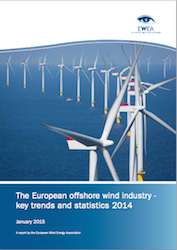The European offshore wind industry has stabilized with new capacity installations declining by 84 MW in 2014 as compared to 2013 according to the new report, “The European offshore wind industry-key trends and statistics 2014“. During 2014, 408 new offshore turbines were fully grid connected, adding 1,483 MW to the European system. The total installed capacity for Europe now stands at 8,045MW in 74 offshore wind farms in 11 European countries.
Justin Wilkes, deputy chief executive officer of the European Wind Energy Association, said, “It is not surprising that we see a levelling-off of installations in 2014 following a record year in 2013. The industry has seen exponential growth in the early part of this decade and this is a natural stabilising of that progress. Offshore wind will have a monumental part to play in the EU’s energy security drive as part of the European Energy Union but it  is political determination that will help Europe unlock its offshore wind potential.”
is political determination that will help Europe unlock its offshore wind potential.”
Wilkes noted that the technology and financing are there but long-term policy support is not. This is needed to to avoid the stop-go growth the offshore wind industry has been experiencing.
In 2014, the UK accounted for over half of all new installations (54.8%) with Germany in second (35.7%) and Belgium (9.5%) making up the rest. But for 2015, Germany is expected to install more offshore capacity than the UK, which has dominated installations in Europe for the past three years. The largest wind farms to be fully completed will be RWE’s Gwynt y Mor (576MW) in North Wales followed by Global Tech 1 (400MW) in the German North Sea.
Wilkes added, “Germany is set to buck the trend this year. The UK has more installed offshore capacity than the rest of the world combined but this year shows that other countries in the EU are making serious investments in the sector. The nine financial deals closed in 2014, of which 4 were “billion-Euro” projects, suggest that activity will pick up substantially as of 2017 as these projects begin to hit the water.”

